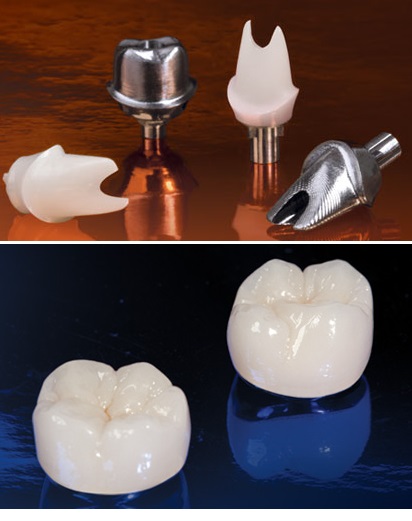|
Frequently Asked Questions
1.How many days/weeks advanced notice do you need before
beginning my treatment program?
2.How many hours each day will I be at your facility? How
many days are required to complete the treatment?
3.Why do you recommend the high noble metal porcelain
crowns to restore my teeth?
4.What is a sinus lift? How long a period of time should I
wait for the implant placement after the sinus lift?
5.Who is a candidate for dental implants?
6.What is the difference between two stage and one stage
dental implants?
7.How the treatment proceeds?
8.What are the steps to follow after I make the decision
to visit your clinic?
9.What are the options to replace the missing teeth?
10.What is a dental implant?
11.What material is used for dental implants?
12.How is the treatment?
13.What is the surgical phase?
14.How is the post-operative stage?
15.When will the new teeth be placed on the dental
implants?
16.Is it a painful treatment?
17.Could there be a failure?
18.What does it happen if a dental implant fails?
1. How many days/weeks advanced notice do you need before
beginning my treatment program?
We need to be notified at least 2 weeks before you come to
Panama, in order to prepare for you a “day by day”
itinerary and confirm your appointments.
2. How many hours each day will I be at your facility? How
many days are required to complete the treatment?
Most of the dental treatments need 12 days for completion.
During these days our lab technicians will be preparing
the permanent crowns that will cover your teeth.
The hours during each appointment depend on the process;
however, most of the time it takes between 2 and 3 hours.
3. Why do you recommend the high noble metal porcelain
crowns to restore my teeth?
Grinding your teeth, an improper bite, age, fillings and
tooth decay can all be contributing factors in the wearing
down, cracking or breakage of your teeth. Dental crowns
cover the entire visible surface of your affected tooth
and add strength, durability and tooth stability.
4. What is a sinus lift? How long a period of time should
I wait for the implant placement after the sinus lift?
Sinus lifts, sometimes called a sinus augmentation, is
surgery that adds bone to your upper jaw in the area of
your molars and premolars. Once the procedure has been
done, you will need to wait about 6 to 8 months in order
to be able to place the implants.

5. Who is a candidate for dental implants?
Candidates for dental implants need to have healthy gums
and adequate bone to support the implant. This is the
reason why we request your dental records and panoramic
x-rays.
If your answer is affirmative to some of the following
questions, you can be considered an ideal candidate to be
treated with implants: •Have you lost one, some or all of
your teeth?
•Do you have difficulties with your removable denture (bad
retention, pain, etc)?
•Do you feel insecure when you smile, when speak or eat?
•Has a dentist told you that you have teeth in very bad
shape?
•Is there an area in your mouth where the corresponding
tooth never showed up?
6. What is the difference between two stage and one stage
dental implants?
a) Traditional: Using the traditional implant process,
placements in the lower jaw need about three months to
heal while placements in the upper jaw need about six
months to heal. Traditionally, the procedure has been
performed in two steps. The dentist begins by installing
the implant, which was left for three to six months to
heal and integrate with the jawbone. During the healing
period, the patient was given a temporary prosthesis until
the permanent crown could be put into place. Traditional
dental implants required patients to sacrifice much of
their time and money to achieve the look and feel of
natural-looking teeth.
b) One Stage Dental Implant: Osseo (bonding with your
natural bone) integration begins immediately. No long wait
for the bone to heal before placing the implant. There are
no missing teeth in the mouth because we place your
temporary crowns immediately on the post. The tooth looks
natural while the implant is healing.
Although the integration of bone tissue and the implant
device takes place normally, the physical characteristics
of the implant device itself creates the solid
infrastructure that enables immediate use.
7. How the treatment proceeds?
FIRST APPOINTMENT: The first step is to place the
implants, once the implants have been placed, an
impression is made. A very accurate model is made from
this impression from which the lab will make the permanent
bridge or the crowns. (Bridges and crowns are usually made
of porcelain with a metal substructure. The porcelain
gives it esthetics and durability and the metal underneath
allows for strength and a good fit). When the impressions
have been taken, a temporary tooth is made and it will be
similar to the final bridge and / or crown, though not as
durable. It is cemented with temporary cement for the days
that the lab technicians will be making the permanents.
The temporary keeps the teeth comfortable and keeps the
teeth from drifting.
Be careful not to eat hard or sticky foods with the
temporaries, since they are not as durable as your
permanent bridge or crowns. If your temporaries do come
off, it is important to have them re-cemented to prevent
teeth from drifting.
SECOND APPOINTMENT: Once the bridge or crown is done (7
days after the first appointment), it is fixed with a
permanent cement.
FINAL APPOINTMENT: Between 12 to 24 hours after the
permanent crowns placement, you will be scheduled for the
final appointment for final adjustments and where the
doctor will make sure there are no problems.
8. What are the steps to follow after I make the decision
to visit your clinic?
First of all you should decide on the date you wish your
procedure to begin, bearing in mind our two week notice
policy period. We will then prepare a preliminary day by
day itinerary, you will then have the dates needed to
purchase your airline tickets.
9. What are the options to replace the missing teeth?
The first option is place an artificial titanium root
(dental implant) that will support a porcelain crown. The
next option is the bridge, which consists on trimming the
neighbor teeth, to make porcelain crowns on them fixed to
another crown that will replace the lost tooth. The third
is a removable denture, which is retained by hooks, and
stabilized by a plastic or metallic structure that covers
the palate or the tongue zone. The patient can remove it
from the mouth.
10. What is a dental implant?
Dental implants are small titanium cylinders that work as
artificial dental roots, once they are placed inside the
jawbone. This way the artificial teeth can be anchored in
these new roots contributing to recover a beautiful smile,
as well as a comfortable speaking and chewing. Dental
implants will allow us to chew with total comfort, and to
smile and speak with the same security than with our own
teeth. With the use of the dental implants, there is no
need to touch, trim or injure the neighbor teeth, to
replace the missing tooth.
11. What material is used for dental implants?
Along the history of dentistry and medicine, many
materials have been used. At the present time, the only
material considered valid for dental implants is titanium.
12. How is the treatment?
The treatment consists on two stages:
a. Surgical phase
b. Prosthetic phase.
13. What is the surgical phase?
The surgical treatment consists on the placement of the
artificial roots or implants inside the jawbone. It is
performed with local anesthesia, and is painless. Sedation
and general anesthesia are options for nervous patients.
The duration of the intervention is from one to two hours.
14. How is the post-operative stage?
It is not painful. The following day of the intervention
the patient will have a slightly inflamed area in the
face. Painkillers, antibiotics and anti- inflammatories
are prescribed for a short period.
15. When will the new teeth be placed on the dental
implants?
The time between the surgical phase and the placement of
the crowns varies depending on the case.
The range varies between seven and ten days, to give time
to the implant to integrate or fix to the bone. More time
could be waited if the patient asked so (i.e. because of a
trip).
16. Is it a painful treatment?
No, it is not. A treatment with implants demands a
surgical intervention, but pain and all the other
implications can be perfectly controlled.
17. Could there be a failure?
In spite of the excellent clinical results obtained with
implants (93 to 97% success rate) there is a 3 to 7% rate
for failure. No other dental treatment has such a high
success rate for long terms.
18. What does it happen if a dental implant fails?
If an implant fails, it is possible to substitute it for
another one to solve the problem after the jaw has healed.
|
C L I N I C
E X P R E S S D e n t a l
O f f i c e
MORE ABOUT
IMPLANTS AND FULL MOUTH RESTORATIONS...
How many teeth can be supported by dental implants?
All the common forms of tooth replacement, such as
bridges or dentures can be replaced by dental
implants.
If you are missing one natural
tooth, then one dental implant is normally all that
will be needed to provide a replacement.
Larger spaces created by two,
three of more missing teeth do not necessarily need
one dental implant per tooth, however the exact
number of dental implants will
depend on the quality and volume of bone at each
potential dental implant site.
Occasionally, it is even possible
to join natural teeth to dental implants with a
conventional bridge. In the upper jaw, bone density
is generally poorer than in the lower and if you
have no teeth at all, most treatment providers will
want to place a minimum of 6
dental implants to support a complete arch of 10
or more replacement teeth.
In the lower jaw, the bone towards
the front of the mouth is often very strong and as a
direct result, fewer dental implants may be needed
than are required to treat a whole upper jaw.
A simple treatment plan to provide
10 or more teeth in the lower
jaw might be possible with as few as 4 dental
implants, although it is still more common to
use 5 or 6. |
|
|
'SEE MORE IN
WWW.VEASEPANAMA.ORG |
 |
The procedure goes normally few steps.
In the first step an X-ray is taken to see if there
is enough bone and to look at the bone quality. One
can do this by taking a big x-ray called OPG , but
mostly a dental scan or CT-san is taken to see the
area in full 3D .
They recently often do that with
the guide of specialized computer programs.
The latest development is a
computerized prefabricated guiding model , so the
surgeon can do a guided surgery.
In a second step the implant is brought into place..
The patient gets normal a local anaesthesia and the
implant is placed is less then 20 minutes .
Opening the gums is not
necessary anymore, just a little hole is punched
through it.
When the canal is almost as large as the implant,
the implant is screwed in If required, some stitches
are placed and the gums are closed. Whenever more
implants are placed , usually this done in the same
session. When this
procedure is done, in some cases the implant is
covered by a healing cap that sticks through the
gums and can be visually detected.
This is called a “one-phase”
healing procedure. When the implant is fully covered
with gums the healing abutment is placed after a
second surgery phase a few weeks later, the healing
time , meaning the time
that the bone needs to fully osseo-integrate the
implant, is about 2 months for the lower jaw and
four months for the upper jaw.
|
|

All-On-Four Dental Implants
All-on-four dental implants is where the entire
edentulous upper or lower arch is restored with a
fixed restoration anchored by four implants. In
all-on-four, a fixed temporary restoration is placed
on the same day of surgery similar to teeth in a day
concept.
In all-on-four, the dental implants are placed in
the front part of the jaw avoiding the need for bone
grafting, sinus lifts, nerves, second surgery and
other vital structures.
Two of the implants are placed near the front
midsection of the jaw while, the back implants are
angled to avoid vital structures and to provide for
a favorable restorative mechanics.
All–on–Four is a
good option for patients who have battled with gum
disease for a long time and have reached the point
where the remaining teeth must be removed.
These patients can have the teeth removed and
implants placed along with a fixed temporary
restoration on the same day.
The result is very well received
by these patients and at times it’s emotional and
dramatic as their lifetime struggles with bad teeth
are resolved in a short period.
Limitations of all-on-four dental implants
All-in–Four dental implants require the presence of
a considerable vertical
space “arch height” for adequate
restoration. If the space is not adequate, bone
removal to reduce the height of the arches is
required thus creating more space. In some patients
bone removal may not be possible as they may exhibit
a minimal amount of existing bone which is just
enough to retain the implant. In these cases other
alternatives must be explored.
Advantages of all-on-four dental implants:
There are several advantages of all-on-four over
other fixed full arch restorative options
- - Less costly than other full arch fixed
restorative options
- There is no need for second surgery such as bone
grafting and sinus lifts
- Greater measure of safety by avoiding vital
structures
- The simplicity of this concept produces higher
level of predictability with less complications
Implant Supported Dentures
The addition of at least two dental implants per
arch to support dentures can increase the degree of
retention significantly. Retaining dentures with
dental implants allows for much more chewing and
biting ability of tougher foods like meat, lettuce
and apples. There are several ways by which dental
implants can support and help retain a removable
denture:
Removable dentures with two dental implants
Two dental implants are the minimal number of
implants that can be used for retain full upper or
lower dentures. These two implants are usually
placed around the eye teeth position.
Using three or four dental implants to retain full
dentures allows for even higher degree of retention
and stability. More importantly it eliminates the
unfavorable fulcrum forces on the bone. These forces
are associated with using two dental implants to
retain full dentures.
More
importantly, using more than two implants on the
upper arch allows us to eliminate the denture
coverage of the roof of the mouth. This allows for
the tactile feel of food against the roof of the
mouth which translates to a much more enjoyable
eating experience
see more..
Dentures Supported by Two
Dental Implants
Dentures supported by two dental implants
Removable dentures with three or more dental
implants
Dentures supported by Four Implants
Denture Supported By Four Implants
Bar retained dentures supported by dental implants
In certain cases we may utilize a metal bar that
connects the implants to retain full dentures. Clips
or other attachments can be fixed into the dentures
and bar to retain and secure the denture on top of
the bar
|
|
 Envíe un mensaje a web-designer con preguntas o comentarios sobre este sitio Web Envíe un mensaje a web-designer con preguntas o comentarios sobre este sitio Web
Precio sujeto a cambio sin previo aviso / Envíe un mensaje a web-designer con preguntas o comentarios sobre este sitio Web Última modificación:
15 / 04 / 2017 /
Copyright © 2017 Panama Clinica Express -Reservados Todos los derechos
.
copyright
panamaclinicexpress.com - Términos Legales. Todos los precios
del portal estan sujetos a cambio sin previo aviso. Esta empresa
no se responsabiliza por diferencias entre las imagenes y los
productos reales, ni la descripcion, la configuracion y el
contenido real del articulo ya que todos las descripciones son
copiadas y pegadas de catálogos de sus fabricantes, además se
entiende que el cliente debe averiguar y asesorarse
correctamente antes de hacer la compra. Nuestros precios no
incluyen IVA y son de condicion contado. El cliente acepta los terminos y condiciones al momento de confirmar su operación. PRICE IS SUBJECT TO CHANGE WITH OUT
PRIOR NOTICE, WE WELCOME ONLINE CONSULTATIONS AND THEY ARE FREE
FOR FINAL PRICE REQUEST, WE ANSWER IN YOUR PREFERRED
LANGUAGE, SPANISH - ENGLISH, ALSO OUR JOBS
COME WITH A GUARANTEE
OF SATISFACTIONS.
Por supuesto, el precio de los
tratamientos de odontología es un aspecto a tener muy en cuenta en
nuestra decisión. Sin embargo, no perdamos el mundo de vista. Existen
clínicas dentales más económicas que otras. Pero debemos poner el precio
de nuestra clínica dental en relación con la calidad de los servicios
que ofrece. No existen las gangas ni los milagros cuando se trata
nuestra boca
Nuestras clínicas dentales cuentan con todas las tecnologías de la
odontología moderna y dentistas especialistas que están al día de las
técnicas más avanzadas necesarias para diseñar la sonrisa y ofrecer las
mejores soluciones odontológicas disponibles en la actualidad.
Si invertimos, pues, un mínimo de tiempo en analizar separadamente todos
estos aspectos, se reducirá notablemente el espectro de clínicas que
puedan interesarnos.
El odontólogo aconseja asesorarse bien antes de recurrir a cualquier sitio, es importante acudir a una institución donde se ofrezcan garantías sobre el procedimiento realizado.
|
| |
 |
|
|
            Por Central Falls Web
Por Central Falls Web
|
|
|